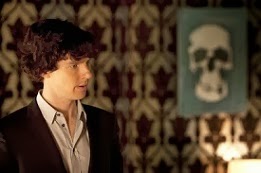The final episode of Season 2 is inspired by the original story: The Final Problem. Here are the references to Arthur Conan Doyle's original stories:
1. Lestrade thanks Holmes for capturing Peter Ricoleti, # 1 in Interpol's Most Wanted List - Holmes mentions about his earlier cases in The Musgrave Ritual: “Here’s the record of the Tarleton murders, and the case of Vamberry, the wine merchant, and the adventure of the old Russian woman, and the singular affair of the aluminium crutch, as well as a full account of Ricoletti of the club-foot, and his abominable wife.”
2. Holmes is reluctant to wear the Deerstalker. This is a running gag in the second season - This is reference to the fact that Arthur Conan Doyle had not envisioned or written about Holmes wearing the Deerstalker. It was Sidney Paget, the illustrator who create the image of Holmes wearing that particular cap.
3. John asks Sherlock: “Pressing case, is it?”. Sherlock's reply: “They're all pressing 'til they're solved.” – From The Hound of the Baskervilles: “I had waited patiently for the opportunity for I was aware that he would never permit cases to overlap, and that his clear and logical mind would not be drawn from its present work to dwell upon memories of the past.” And “Perhaps you would kindly give me a sketch of the course of events from memory.” “Certainly, though I cannot guarantee that I carry all the facts in my mind. Intense mental concentration has a curious way of blotting out what has passed. The barrister who has his case at his fingers' ends and is able to argue with an expert upon his own subject finds that a week or two of the courts will drive it all out of his head once more. So each of my cases displaces the last, and Mlle. Carere has blurred my recollection of Baskerville Hall. To-morrow some other little problem may be submitted to my notice which will in turn dispossess the fair French lady and the infamous Upwood.”
4. Watson referring to Moriarty: “He is back” – Holmes states about Professor Moriarty in The Valley of Fear: “No less! When any of that party talk about “He” you know whom they mean. There is one predominant “He” for all of them.”
5. Sherlock's deduction at Moriarty's crime scene: “not tougher than crystallised carbon. He used a diamond” – Dr Watson mentions that Holmes is a “first-class chemist” in A Study in Scarlet.
6. Press headline referring to Sherlock as “Amateur detective” – In A Study in Scarlet, Holmes is similarly referred to in press coverage of the case: “The man was apprehended, it appears, in the rooms of a certain Mr. Sherlock Holmes, who has himself, as an amateur, shown some talent in the detective line and who, with such instructors, may hope in time to attain to some degree of their skill.”
7. Sherlock deducing that Kelly is typing – Reference to a similar deduction about Miss Sutherland from A Case of Identity: “The double line a little above the wrist, where the typewritist presses against the table, was beautifully defined.”
8. Sherlock deducing oil from the printing press from its scent and later smells linseed oil - Holmes has always had a sharp sense of smell. He mentions in The Hound of the Baskervilles:
“There are seventy-five perfumes, which it is very necessary that a
criminal expert should be able to distinguish from each other, and cases
have more than once within my own experience depended upon their prompt
recognition.”
9. Sherlock deducing based on Kelly’s fingernails - In A Study in Scarlet,
Sherlock Holmes states:
“By a man's finger nails, by his coat-sleeve, by his boot, by his
trouser knees, by the callosities of his forefinger and thumb, by his
expression, by his shirt cuffs - by each of these things a man's calling
is plainly revealed.”
10. Kitty's offer of help to Sherlock: “There’s all sorts of gossip in the press about you. Sooner or later you’re gonna need someone on your side.. someone to set the record straight.” - Holmes tells Watson in The Adventure of the Six Napoleons: “The Press, Watson, is a most valuable institution if you only know how to use it.”
11. Sherlock coaching the attorney about how to question him & mimicking the judge word for word - Dr Watson mentions about Holmes in A Study in Scarlet: “Has a good practical knowledge of British law.”
12. Jim Moriarty's line: “Every fairy tale needs a good old-fashioned villain” - Holmes expresses his skepticism about the case in The Adventure of the Sussex Vampire: “But what do we know about vampires? Does it come within our purview either? Anything is better than stagnation, but really we seem to have been switched on to a Grimms’ fairy tale.”
13. Jim's boast: “I could blow up NATO in alphabetical order” – Holmes states about Professor Moriarty in The Valley of Fear: “The greatest schemer of all time, the organizer of every deviltry, the controlling brain of the underworld, a brain which might have made or marred the destiny of nations—that's the man!”
14. Jim's statements: “The man with the key is King” and “Honey, you should see me in a crown” - Holmes describes Professor Moriarty in The Final Problem: “He is the Napoleon of crime, Watson.”
15. Jim's promise to Sherlock: “I owe you a fall, Sherlock” - Reference to Professor Moriarty's warning to Holmes in The Final Problem: “You hope to beat me. I tell you that you will never beat me. If you are clever enough to bring destruction upon me, rest assured that I shall do as much to you”
16. When discussing about his new neighbors, John speculates that he might be Sherlock's friend. Mycroft laughs and replies: “Of Sherlock’s?” –
- Dr Watson mentions about Holmes in The Valley of Fear: “Holmes was not prone to friendship….”
- Holmes tells Watson about his network of friends in The Five Orange Pips: “Except you, I have none”
- In The Adventure of the Gloria Scott, Holmes talks about his college days: “I was never a very sociable fellow, Watson, always rather fond of moping in my rooms and working out my own little methods of thought, so that I never mixed much with the men of my year.”
17. Ludmila Dyachenko, the new neighbor who is also an assassin – Reference to the rumor that Ludmilla Hubel, the alleged lover of Archduke John Salvator of Austria was the inspiration for ACD to create the character of Irene Adler
18. Sherlock's comment on Anderson's deductions: “Brilliant impression of an idiot” - Dr Watson writes about Holmes in The Adventure of the Bruce-Partington Plans: “It was one of my friend's most obvious weaknesses that he was impatient with less alert intelligences than his own.”
20. Sherlock deducing that the kidnapped boy was anxious because he was walking on his tiptoe - In The Hound of the Baskervilles, Holmes deduces that Sir Charles Baskerville was running for his life based on the fact that his footprints indicated that he was walking on tiptoe down the alley.
21. Sherlock's statement: “All the chemical traces on his shoe have been preserved. The sole of the shoe is like a passport. If we’re lucky we can see everything that he’s been up to.” - Dr Watson writes about Holmes' expertise in A Study in Scarlet: “Geology - Practical, but limited. Tells at a glance different soils from each other. After walks has shown me splashes upon his trousers, and told me by their color and consistence in what part of London he had received them.”
22. Sherlock's comments about the homeless network: “Faster than the police” - In A Study in Scarlet, Holmes speaks highly of the Baker Street Irregulars: “There’s more work to be got out of one of those little beggars than out of a dozen of the force.”
23. Sherlock further comments that the homeless network is “far more relaxed about taking bribes” - In The Sign of the Four, Holmes paid an advance of one shilling to each of his Irregulars with the promise of one guinea to the one who finds Mordecai Smith’s boat.
In addition, Holmes has also bribed a number of other characters, including the constable John Rance in A Study in Scarlet, Mrs Mordecai Smith in The Sign of the Four, the cabbie John Clayton in The Hound of the Baskerville.
In addition, Holmes has also bribed a number of other characters, including the constable John Rance in A Study in Scarlet, Mrs Mordecai Smith in The Sign of the Four, the cabbie John Clayton in The Hound of the Baskerville.
23. Sherlock correctly deducing about mercury poisoning - In A Study in Scarlet, Dr Watson writes that Holmes is “well up in belladonna, opium, and poisons generally”
24. John asks Sherlock twice not to show too much happiness around the crime scene, since children have been kidnapped - Dr Watson writes about Holmes' reaction to John Hector McFarlane's predicament in The Adventure of the Norwood Builder: “My companion's expressive face showed a sympathy which was not, I am afraid, entirely unmixed with satisfaction.”
I will be listing the remaining references in another post.
Click here to read all my posts about BBC Sherlock.
Click here to read all my posts about BBC Sherlock.
Image Sources: BBC Wales, Hartswood Films, Masterpiece Theatre
You might also like:
 |
| Canonical Nods in "The Empty Hearse" |
 |
| Canonical Nods in "A Study in Pink" |




